When U.S. troops arrived in post-war Berlin to take a hold of the sector assigned to them, one of the first things they accomplished was to install a broadcasting facility for AFN, the American Forces Network, whose task was informing and entertaining its GI audience. Berlin citizens whose radios had survived the war could tune in on the new station. Among the listeners was the family of a little boy whose parents had narrowly escaped the Nazi terror and had welcomed Patton's 2nd Armored Division with its fighting name “Hell on Wheels” as liberators.
One of the songs frequently played on AFN was “Chattanooga Choo Choo”, sung by the Andrews Sisters. The boy was fascinated by the tune, took it to his heart and soon sang a few lines of it. To the amazement of the people around him he sounded genuinely American, thanks to the ease with which small children learn a language – with all the temporary shortcomings: Track 29 became twack..

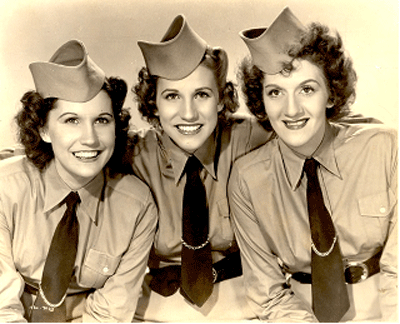
As it turned out, AFN Berlin was to play a major role in developing a very special German-American relationship: Little Klaus soon learned to find 935 kilohertz on the dimly lit dial of the battered old set, and whenever he found the chance he would sit with his ear glued to the coarse textile cover of the small speaker, absorbing all the exotic sounds. In the beginning he would get on his father's nerves, asking: ”What are they saying?” Luckily, his dad, who had a good foundation of school English, helped him to gradually build up his vocabulary. Thus the AFN disc jockeys and newscasters became the boy's steady companions and complementary teachers throughout his childhood and youth.
But there was another, just as important aspect where AFN's role was concerned - the musical entertainment it offered. The GI audience in their transatlantic outpost yearned for the sounds that reminded them of home so far away, and the program directors saw to it that this craving was satisfied. But then something happened that the network officers had not counted on or even expected: The American music, strange as it may have sounded to German ears, was gradually accepted and appreciated by a growing number of Berliners. Some of them, including the small boy, felt that this was just the right stuff for them. In that way, AFN formed the boy's musical taste that would become a decisive factor for his way of living. However, neither he nor anyone close to him could have imagined that decades later he himself would be a featured artist on both AFN radio and television. In hindsight he said: “I should thank LaVerne, Maxine, and Patty for finding their way into my heart with their beautiful harmony on Chattanooga Choo Choo and their other hit songs. That definitely got me started on the right track – even if it wasn't track 29..”
Learning and Doing
As the years went by he continued to be fascinated by the music he heard on AFN, and eventually he noticed that he was especially attracted by America's rural music, known in those times as Hillbilly. Among the first songs he learned were numbers by Hank Williams, Roy Acuff, and Eddy Arnold. Taking in the lyrics was no problem, but since there was no tape recorder available, copying the words required a special technique: When the song came on one would write down the first line, skip the second and third and jot down the fourth, and so on. Thus it would take at least three times listening to the song to fill in the gaps.
The next step was to accomplish a recording of his own. In order to reach that goal he had to meet two essential conditions: instrumental accompaniment and access to a tape machine. The first part was achieved by the purchase of a no-brand six-string banjo and learning three significant chords: E, A, and - not so easy – B7. Part two was made possible by a good friend, appropriately called Stranger, who not only sang and played guitar but also had a neighbor who owned a wire recording device. And so, this was the first recording of the duo: “Heaven”, a spiritual song heard on the radio, done by Lester Flatt and Earl Scruggs with the Foggy Mountain Boys.
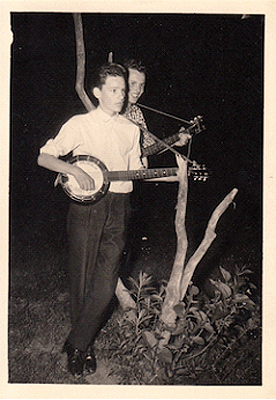
After this rather modest debut by the two Berlin teenagers, Lonnie, who had not acquired that name yet (for the sake of accurate chronology the circumstances of that name change will be disclosed later), felt even more determined to sing and play and to improve his performing standard. That included getting better at playing – a chore he chose to be reminded of daily by a little poster he pinned on the wall of his room..

As luck would have it, Helge Brink, one of his classmates in junior high, happened to be a violin player who was devoted to classical music. It took Lonnie months and months of touting before the youngster agreed to venture into the field of country music, which required learning things like the single-note fiddle licks introduced on Ray Price songs as well as the bow rhythm that is typical for lively up-tempo numbers such as 'Cotton Eyed Joe'. Moreover, there was an unexpected bonus: The talented violinist owned a rich tenor voice that was to contribute to the very specific sound of the band both of them would play in later on.
Another step in that direction came when the two of them met a small group called 'Rockabilly Boys', hired to play at a dance of their high school. During a break both sides agreed on a few common songs – the result was the instant merger of the two factions..
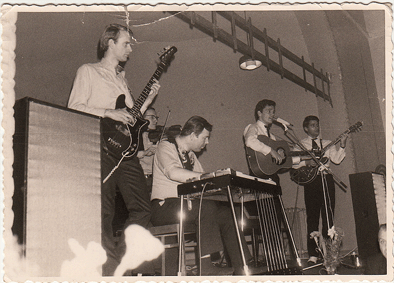
This short excerpt from the Rockabilly Boys' version of Hank Locklin's giant hit “Send Me The Pillow That You Dream On” briefly demonstrates the new sound of the expanded group. Not long after that a new dimension lay in store..
The Berlin Ramblers
Some of the roughly 5,000 American soldiers stationed in Berlin had been musicians at home, and a few of them decided to continue playing and singing in their off-duty hours. One of the bands formed in that spirit became known as the “Berlin Ramblers” - the name being a combined tribute to the military assignment in the “Divided City” and to the southern roots of the group members. The Ramblers entertained their fellow GI's with country songs, performing at the enlisted men's and NCO clubs of the different compounds – McNair and Andrews Barracks and Tempelhof Air Base.
The repertoire of the Ramblers was solid, but what they lacked was continuity: Usually, the military tour of duty would last two years, the completion of which was yearned for by all drafted soldiers who couldn't wait to return to civilian life, but even the career members of the forces were often transferred to new locations after two years. The repeated exchange of personnel put the structure of the Ramblers in jeopardy. And it was this situation that led to the fact that Lonnie - thanks to the right contacts - became the first German singer of the Ramblers, when the Americans could not find a suitable replacement for their lead singer who had returned to North Carolina. Lonnie was joined by other Germans, and eventually the group consisted solely of native Berliners.
The picture, taken at the German-American Volksfest of 1962, shows the Ramblers in their transition phase with both American and German members.
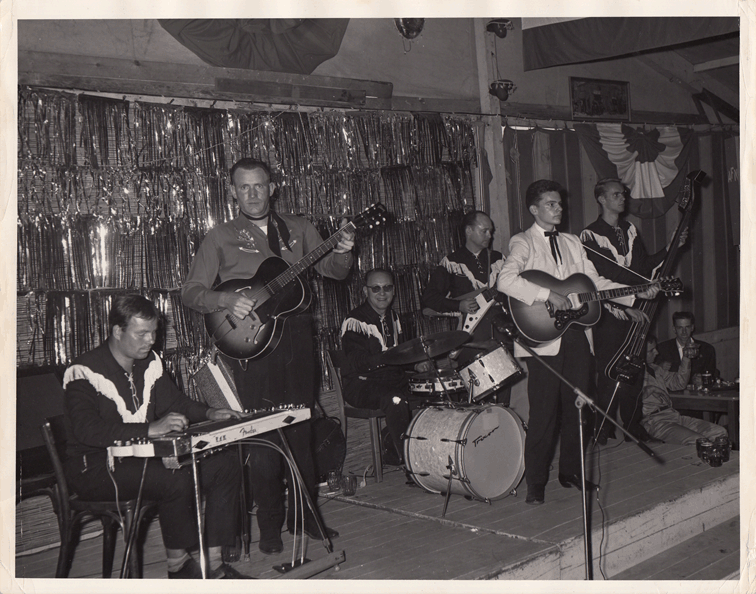
From left to right: 'Hook' Minck, steel guitar; Sgt. Jesse Childers, vocals, rhythm guitar; Joe Novak, drums; Sgt. Doug Watson, lead guitar; Lonnie, vocals, rhythm guitar; 'Micky' Marock, bass.
In that historic photograph Lonnie is seen with a guitar that led to an unexpected impact on his appearance as an artist. He remembers: “The first instrument I bought had been a ridiculous-looking six-stringed banjo which never sounded good. My reasoning back then was that I was equally fascinated by the guitar and the banjo, and I hoped to be able to get a bit of both that way, but I was wrong. So I put that thing in the back of my closet, and for a while I borrowed guitars for gigs we had, but after joining the Ramblers I decided to get a decent guitar of my own. One day, as I passed a pawn shop downtown, I spotted this cherry red sunburst copy of a Gibson Jumbo in the window, and I knew I wanted it. What I hadn't noticed right away was the mother-of-pearl inlaid neck displaying the name 'Lonnie Jethro'. Because of that unwanted attribute I managed to get the price reduced a bit, but what I hadn't counted on was that people thought it was my name and called me by it; GI's would come to the stage and ask: 'Hey Lonnie, play this short timer song!' At first I tried to correct them but when it kept happening I changed my mind, thinking 'What the heck, I might as well accept that stage name, as long as they don't call me Jethro as well'... By the way, I never found out the identity of the guy that had owned that guitar earlier.”
A few years later the cherry red Jumbo was replaced by a Martin D-28. The only neck inlay it had were the eight dots that help finding the right frets.
In 1966 Sergeant Jesse Childers, the last American member of the Ramblers, was transferred to Vietnam. However, his departure did not affect the group's bookings by the military clubs – on the contrary: Their performance frequency increased and finally peaked at five to six shows every week. One of the places they performed at regularly was the “Starlight Grove” at McNair Barracks.
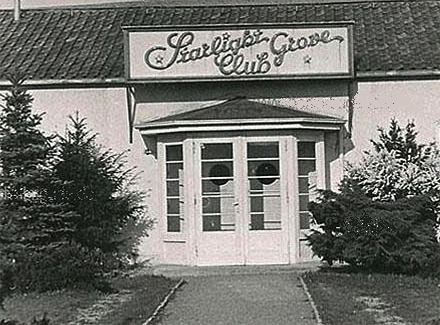
Even though the technical quality of the following amateur recording is not what it could have been, you will get an impression of the typical sound of the Ramblers, as they start one of their performances at the service club..
Thank you, Mr. Ambassador
In the spring of 1968, the American ambassador to the Federal Republic of Germany, George C. McGhee, voiced a special request for the farewell party that would mark the end of his diplomatic term in Europe: A native of Waco, Texas, McGhee wished to have a Country and Western band provide the main part of the musical entertainment at the shindig that the headquarters of the U.S. Army Europe (USAREUR) in Heidelberg would arrange for him. To make sure that this task would be successfully accomplished, USAREUR headquarters assigned a special team of talent scouts to travel to all major U.S. military bases in Germany to locate a band suited for the occasion. After several months of searching, the team unanimously recommended the Berlin Ramblers.
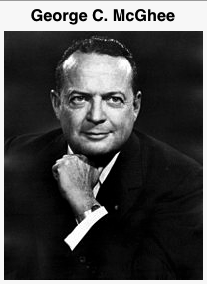
The farewell party in May was a colorful, high-echelon event with a variety of entertainment facets. When it had ended, the ambassador took the time to shake hands with all the Ramblers, saying: “Your music has made me realize what I've missed over here.”
That same year held another pleasant surprise in store for the band. Berlin was one of the locations where AFN broadcast programs not only on radio but also on television. Since its start in 1967 AFTV Berlin mostly aired tapes of shows that were popular in America. Those were chosen by the AFRTS - short for Armed Forces Radio and Television Service - in Los Angeles and flown to Berlin. The programs were in black and white, and the small range of the low-power transmitter meant that reception was roughly limited to Berlin's American sector. Germans who wanted to watch channel 29 had to get a converter to synchronize the sound with the picture.
After the basic routine had been established, the TV staff decided to add some local program elements: Soon there were daily live newscasts for the military community as well as a few taped features meant to help the Americans getting to know Berlin and its sights. And then one day the station manager, Air Force Tech-Sergeant Marvin M. Weiner, invited the Ramblers over to the studio to ask them whether they would be interested in joining the program by playing a half-hour show. He also explained that, due to the sparse situation of the facility, the show would have to be live. That presented quite a challenge which was not exactly risk-free for both sides. What if something went wrong, either with the band's performance or with the technical equipment? After all, neither the musicians nor the station personnel were professionals.. But in the end everybody agreed it was worth to give it a go, and so one summer Saturday the Berlin Ramblers entertained the AFTV audience with the latest songs in the country field. And, since everything went just fine, there were many more Saturday shows to follow – all of them live..
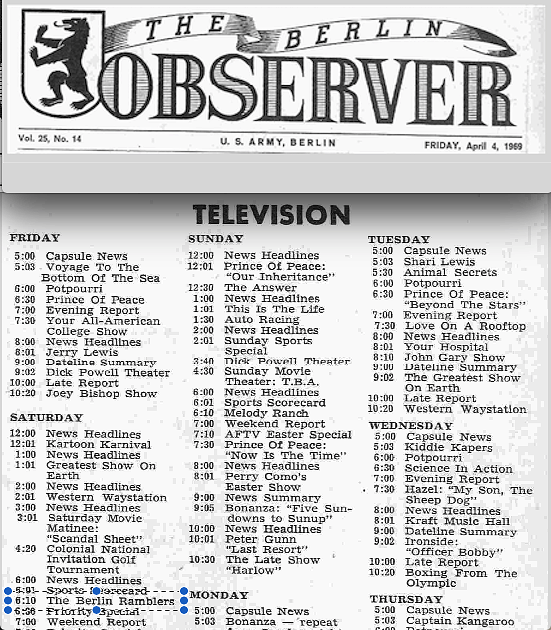
Since the performances were aired directly there are no videos documenting this remarkable phase. Only a few audio recordings survived. In an excerpt of a show taped by a GI viewer you can listen to the conclusion of that particular day's program..

After the first couple of performances the station began receiving phone calls and letters from viewers wanting to see the Ramblers more often. That led to the incredible decision to feature the band not just once a month but e v e r y Saturday. This frequency was maintained for the better part of the following year. By then, some of the band members started facing problems with their spouses who complained about the ever tighter show schedules putting family life in jeopardy. Consequently, in late 1969 the Ramblers' excursion into the world of television came to an end. The mutually enriching commitment is maybe best illustrated by bringing back a special event: Although none of the band's several dozen studio appearances was preserved, there is one single exception: On Saturday, the 13th of July, 1968, the Berlin Ramblers played at the Open House celebration of the Berlin detachment of the U.S. Air Force at Tempelhof Air Base. A thirty-minute portion of their performance was captured on film by an AFTV team and broadcast later that day during the Ramblers' usual air time. The metal drum containing the 16-millimeter film was later given to Lonnie, who eventually converted the material and made it available on Youtube. One of the songs was the Buck Owens hit “Act Naturally” - enjoy!
The Berlin Ramblers from left to right:
Hook Minck, steel guitar - his instrument was the first pedal steel built in Germany. Hook, a mechanics engineer, had equipped a 1953 triple-neck Fender Custom with self-designed pedalry after meeting Buddy Emmons, one of the pioneers of the pedal steel.
Helge Brink, fiddle and vocals - originally a classical music violinist, “the Professor” had been persuaded to venture into country music by high school classmate Lonnie, who eventually secured a place for him with the Ramblers while the band still was run by Americans. Helge's superb tenor voice and his expert handling of the fiddle significantly contributed to shaping the characteristic sound of the group.
Joe Novak, drummer - (hidden behind Lonnie) this always jolly band member provided a solid pillar of rhythm reliability. Thanks to his good-natured ways and a fine sense of humor, Joe added a contagious element of fun to the musical teamwork.
Lonnie Bronner, bandleader - vocals, rhythm guitar, five string banjo
Ina Deter, vocals, rhythm guitar – the beginning of this young lady's musical career was marked by an eighteen-month membership in the Ramblers. A graphic designer by profession, Ina – who used the stage name Anita Lee with the Ramblers - left Berlin after being offered a well-paid job in Cologne.
Micky Marock, bass – the importance of a band's bass player is often underestimated and wrongly classed as secondary. An outstanding bass player such as Micky will provide the steady foundation each and every piece of music requires – and with the hundreds of Rambler songs that is exactly what Micky succeeded with.
Andy Mengel, lead guitar and vocals – after several years as leader of the “Rockabilly Boys” Andy was offered the position as lead guitar player with the Ramblers when their regular lead man, Sgt. Doug Watson, returned to the States. Beside playing a fabulous guitar Andy also was a superb singer who rounded out the wide-spanned repertoire of the Ramblers and their variety.
* * *
Ina Deter's temporary excursion into the country field is acoustically illustrated in this duet recording with Lonnie. The song “It Ain't Me, Babe” is a Bob Dylan composition made famous by Johnny Cash and June Carter. For Ina's fans who may regret that she wears sunglasses in the AFTV clip, here is a picture of what she looked like back then without shades..
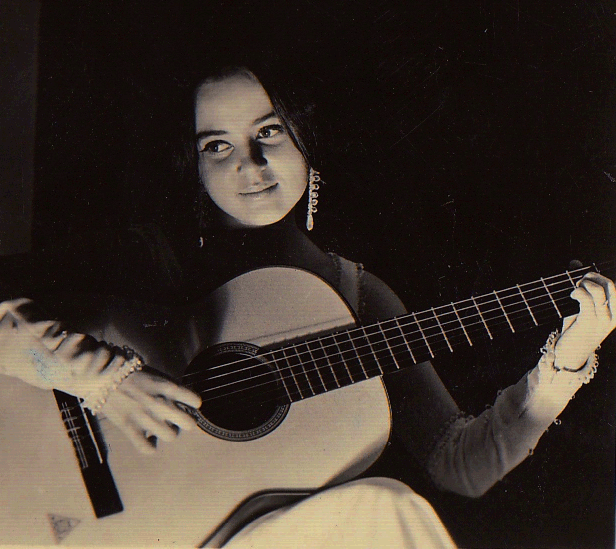
The George Houghton & Sons Banjolele
A musiscian's instruments are the tools of his trade. In the beginning it usually takes a while for him to determine what kind of instrument he wants to master, especially if he has to make that decision by himself, as opposed to a child that is sent to piano lessons by well-meaning parents, without having a say in the matter. Since piano lessons cost money, this option was non-existent for Lonnie's family. So he had to find his way into the world of music on his own. This is what he remembers about the first steps:
“I have enjoyed singing since I was a small child. Both my mother and my grandmother on Mom's side were songbirds, and they encouraged me to sing. So I have to thank them for what they passed on to me. We didn't have any instruments at home, but I enjoyed the sound of the country songs on AFN, and I made up my mind that I would play like that one day. One instrument that really fascinated me was the banjo, and I tried to find out as much as I could about it. In my early teens I worked through summer vacations to make some money, and with some of my early earnings I bought a battered ukulele-sized banjo manufactured by George Houghton & Sons in Birmingham. It was not really suited for accompanying my singing but it helped me to learn to synchronize the two. Of course I soon found out that the small “banjolele” had little in common with its big brothers, the five-string banjos and their brisk staccato sound.
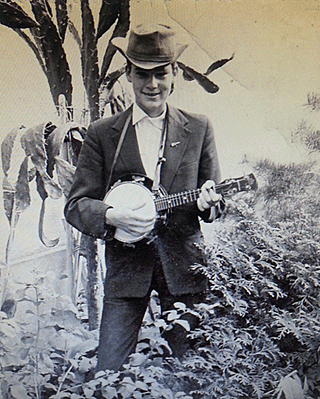
I finally made a compromise: While I actually should have used a guitar with my songs I still loved the banjo, and so I bought a six-string banjo that should give me both – good accompaniment and a knockout sound. But it didn't work the way I had wanted: The harsh banjo tones just would not sound right with the much smoother songs I sang, and so eventually I bought my first guitar.The years went by, and the lttle banjo didn't see any more action. Altogether, only two pictures were taken with the banjolele – the first one shortly after I had bought it, and the last more than a decade later, when we made my son Mark pose with it on his fourth birthday, authentically dressed and equipped, National picks and all..
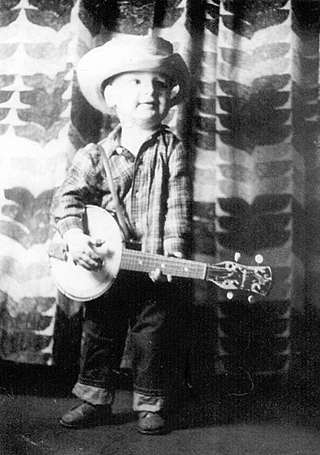
Although I didn't use the little banjo any longer I never thought of getting rid of it, especially since it was the first instrument I had owned. Instead, I kept it on a shelf in my basement, where it rested for many years, safely locked in its worn-out case. Unfortunately, one summer night my home was broken into, and the burglars relieved me of a number of objects, among them the banjolele. I mourned more over its loss than that of other things with a higher material value. Since I am known for never giving up, I spent lots and lots of hours roaming the internet, trying to find a replacement. My chances were slim, however, since my Houghton model was an archtop from a small production series, thus making it extremely rare.
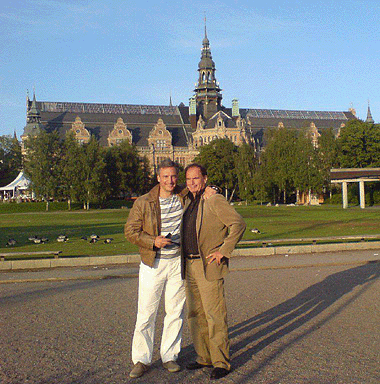
More than a quarter of a century later - about the time this son/father picture was taken - I finally hit paydirt: A collector in Leeds was willing to part with his banjolele. It was originally sold under the brand name of John Grey, but it had actually been manufactured by George Houghton & Sons. In accordance with a license agreement, other companies were allowed to use their own names for the instruments purchased from GHS. So now this long-lost little treasure has been brought back in the identical shape of an equally worthy replacement – another triumph for the cause of nostalgia..”
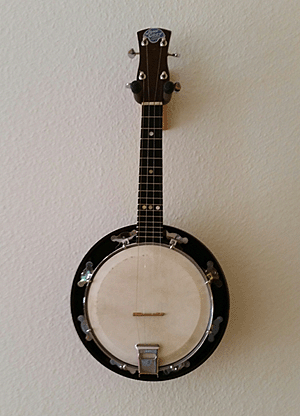

(to be continued)